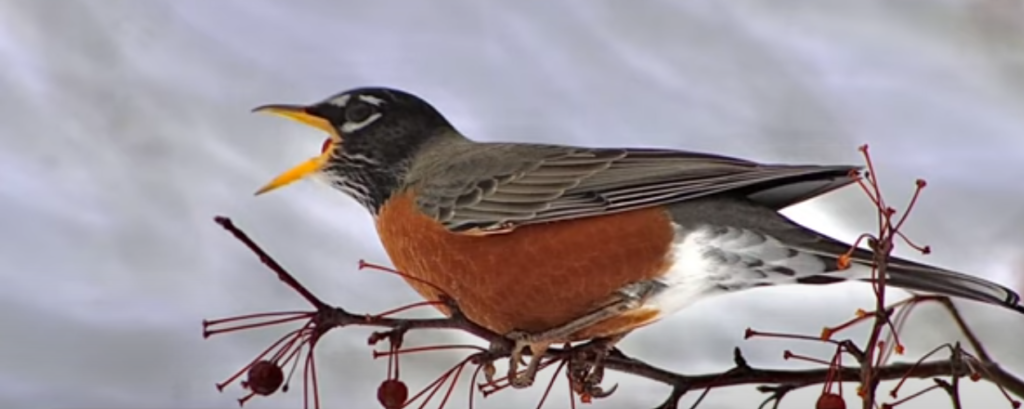Winter of Robins Migration
The behavior of robins during the winter months is intriguing as they Robins Migration to find more favorable environments. Unlike some birds that have a static identity year-round, robins may change their location seasonally.
During colder months, robins typically move towards areas where food is more abundant and the climate is milder. Their migration patterns vary, but many travel from northern regions to warmer southern areas, seeking suitable habitats where they can survive the winter.
Seasonal Movement of Robins Migration:
Distinctive Features and Habits of Robins Migration
Robins Migration are notable for their vibrant red breasts and are commonly seen across various regions during the warmer months. Renowned for their melodious songs, these birds are a delight to ornithologists and bird watchers alike. Their lively behavior and the musical plasmon they produce are emblematic of their species.
Migration Patterns of Robins:
Robins are known to be migratory, typically present in North America during the breeding season. As winter approaches, they systematically move southwards, adapting their migration routes based on geographic factors. These birds undertake extensive journeys, spanning thousands of miles to reach their wintering habitats.
Factors Influencing Robins Migration
Robins Migration primarily due to changes in temperature and food availability. They typically migrate during the day, prompted by decreasing daylight hours and dropping temperatures.

This seasonal movement leads them to regions with warmer climates and more abundant food, where they can comfortably forage. Their journey often begins heading south from their summer habitats.
Where Do Robins Go in Winter?
During the winter, robins travel south to areas where the climate is milder and food sources are more accessible. These regions are crucial for their survival through the colder months, providing ample opportunities to gather the necessary sustenance. Here, robins remain hidden until the warmth of spring encourages their return north.
Read more: Where Do Robins Go in Winter
Robins’ Winter Habitats
While Robins Migration are commonly seen in urban settings such as parks and gardens behind residential areas, they also inhabit natural settings like forests and woodlands. During winter, some opt to stay in urban backyard gardens, which offer a variety of foods including berries and insects.
This adaptability in habitat choice allows them to find suitable shelter and food sources throughout the harsh winter months.
Significance of Winter Shelters for Robins Migration
Essential Survival Strategies
Winter shelters are critical to the survival of Robins Migration, providing essential protection and resources during severe weather conditions. These shelters help robins maintain their well-being by offering a safe place to reside and access to necessary food.
Adaptation to Habitat
Robins adapt their foraging behavior based on the availability of resources in their habitats. These strategic locations are chosen not only for their food supply but also for their ability to shield the birds from potential predators, ensuring their survival through the winter months.
Dietary Changes in Cold Weather
During the winter months, robin birds adapt their feeding habits to cope with the colder conditions. They consume a variety of foods available during this time, such as berries, fruits, seeds, insects, and small invertebrates found in leaf litter and compost piles.
Also read: Dietary Changes in Cold Weather
This dietary diversity is crucial for maintaining their energy levels and overall health during the winter.
Conservation Challenges Faced by Robins Migration
Despite their adaptability, Robins Migration face several threats that impact their survival, including challenges related to winter migration, habitat loss due to climate change, and predation
Human activities like deforestation and urbanization further complicate their ability to find suitable winter habitats.
Efforts to Protect Robins Migration
Wildlife organizations and conservation groups emphasize the importance of protecting and restoring the overwintering conditions for robins. They advocate for community involvement in conserving natural areas, creating habitats for wildlife, and implementing sustainable land management practices.
Read more: Efforts to Protect Robins Migration
These efforts are vital to ensure the health and future generations of the robin population, securing their long-term survival.
Robins’ Winter Survival: Adaptations and Conservation Challenges
Adapting to the Cold: Robins’ Winter Diet
During the winter, robins must adapt their feeding habits to the seasonal scarcity of food. Unlike the warmer months when insects and worms are plentiful, winter forces these birds to shift their diet. They primarily consume available berries, fruits, and seeds.
Robins also forage for insects and small invertebrates in decomposing leaf litter and compost heaps. This varied diet is vital for maintaining their energy levels and overall health during the harsh winter months.

Facing the Cold: Challenges in Robins Migration and Wintering
Robins are highly adaptable, yet they face significant threats that challenge their survival. Winter migration exposes them to numerous hazards, including extreme weather conditions, habitat loss due to climate change, and increased predation risks
As they migrate to and from their wintering grounds, robins must navigate these challenges to survive the season.
Human Impact and Conservation Efforts
Human activities such as deforestation, urban expansion, and environmental pollution further threaten robin populations by degrading and fragmenting their natural habitats. These changes disrupt the robins’ ability to find adequate wintering habitats, directly impacting their chances of survival.
Also read: Human Impact and Conservation Efforts
Conservation groups and wildlife researchers are actively working to mitigate these threats through various initiatives. There is a strong call for community action to conserve natural spaces and create supportive environments for wildlife.
This includes protecting natural habitats, establishing wildlife-friendly urban spaces, and promoting sustainable land management practices.
Conclusion:
Protecting the wintering habitats of robins is crucial not only for the survival of this species but also for maintaining biodiversity. The survival of Robins Migration during winter is a complex interplay of biological adaptation and environmental challenges.
By understanding and supporting efforts to protect these resilient birds, we can contribute to their long-term survival and the health of our ecosystems.
FAQ’s:
Where Do Robins Go in The Winter? Robins Migration
In the winter, robins migrate to warmer southern regions where food sources are more abundant and the climate is milder. This migration helps them survive the harsher northern winters.
What Triggers Robins’ Winter Migration?
The onset of colder weather and reduced food availability prompt robins to migrate south to find better living conditions during the winter months.
How Far Do Robins Travel During Their Migration?
Robins can travel hundreds or even thousands of miles during their migration, depending on their starting point and the severity of the winter.
Do Robins Migrate Alone or in Flocks?
Robins typically migrate in large groups during the daytime, which helps reduce the risk of predation and increases the efficiency of finding food.
What Challenges Do Robins Face During Migration?
During migration, robins face numerous challenges, including harsh weather, scarcity of food, predation, and exhaustion from long flights.
How Do Robins Adapt Their Diet in Winter?
As insects become scarce, robins switch their diet to primarily fruits and berries, which are more plentiful in winter environments, helping them sustain their energy levels during migration.

